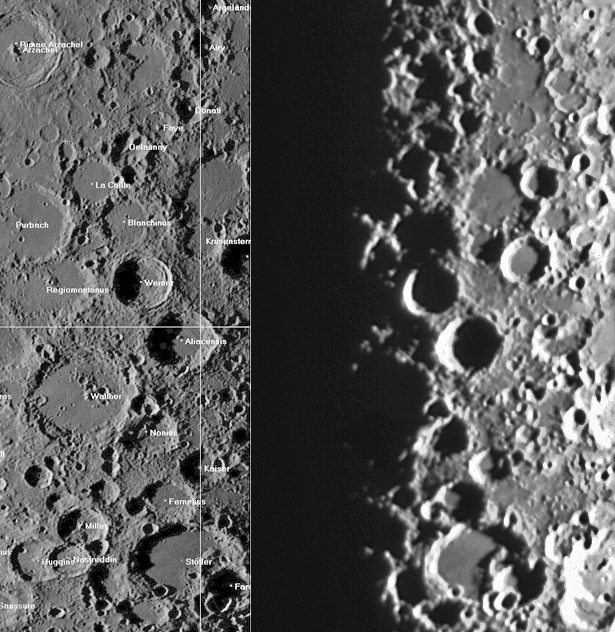Difference between revisions of "January 8, 2010"
| Line 3: | Line 3: | ||
<!-- ws:start:WikiTextHeadingRule:1:<h1> --> | <!-- ws:start:WikiTextHeadingRule:1:<h1> --> | ||
<!-- ws:start:WikiTextLocalImageRule:16:<img src="/file/view/LPOD-Jan8-10.jpg/112294777/LPOD-Jan8-10.jpg" alt="" title="" /> -->[[File:LPOD-Jan8-10.jpg|LPOD-Jan8-10.jpg]]<!-- ws:end:WikiTextLocalImageRule:16 --><br /> | <!-- ws:start:WikiTextLocalImageRule:16:<img src="/file/view/LPOD-Jan8-10.jpg/112294777/LPOD-Jan8-10.jpg" alt="" title="" /> -->[[File:LPOD-Jan8-10.jpg|LPOD-Jan8-10.jpg]]<!-- ws:end:WikiTextLocalImageRule:16 --><br /> | ||
| − | <em>image by [mailto:walker3139@gmail.com | + | <em>image by [mailto:walker3139@gmail.com Tom Walker], Vero Beach, FL</em><br /> |
<br /> | <br /> | ||
Shakespeare called Romeo and Juliet star-crossed because there was no hope for their love. Being Moon-crossed is not a commonly recognized condition (and isn't fatal) but it appears to mean being obsessed with seeing crosses along the terminator. Perhaps Tom is not obsessed, but he was pleasantly surprised to stumble upon one of the well-known crosses. Matching his image with sheets 55 and 65 from Jim Mosher's image [http://the-moon.wikispaces.com/R%C3%BCkl+Index+Map version] of Rükl's <em>Atlas</em> provides locational information. The cross is easy to find, if the terminator is <em>crossing</em> it, because it continues on a line from Aliacensis past Werrner. The cross is a <em>[http://the-moon.wikispaces.com/clair-obscur clair obscur]</em> phenomena that can occur where ever two crater rims touch on an east-west line. Here the rims of Blanchinus and Purbach are reinforced to the north with La Caille, and Purbach's east rim has a high bump to help define the cross's center. Recognizing this cross does nothing to help understand the geology of the Moon, but it is a delight to see, especially if accidently observed.<br /> | Shakespeare called Romeo and Juliet star-crossed because there was no hope for their love. Being Moon-crossed is not a commonly recognized condition (and isn't fatal) but it appears to mean being obsessed with seeing crosses along the terminator. Perhaps Tom is not obsessed, but he was pleasantly surprised to stumble upon one of the well-known crosses. Matching his image with sheets 55 and 65 from Jim Mosher's image [http://the-moon.wikispaces.com/R%C3%BCkl+Index+Map version] of Rükl's <em>Atlas</em> provides locational information. The cross is easy to find, if the terminator is <em>crossing</em> it, because it continues on a line from Aliacensis past Werrner. The cross is a <em>[http://the-moon.wikispaces.com/clair-obscur clair obscur]</em> phenomena that can occur where ever two crater rims touch on an east-west line. Here the rims of Blanchinus and Purbach are reinforced to the north with La Caille, and Purbach's east rim has a high bump to help define the cross's center. Recognizing this cross does nothing to help understand the geology of the Moon, but it is a delight to see, especially if accidently observed.<br /> | ||
<br /> | <br /> | ||
| − | <em>[mailto:tychocrater@yahoo.com | + | <em>[mailto:tychocrater@yahoo.com Chuck Wood]</em><br /> |
<br /> | <br /> | ||
<strong>Technical Details</strong><br /> | <strong>Technical Details</strong><br /> | ||
| Line 17: | Line 17: | ||
<br /> | <br /> | ||
<hr /> | <hr /> | ||
| − | <div>You can support LPOD when you buy any book from Amazon thru [http://www.lpod.org/?page_id=591 | + | <div>You can support LPOD when you buy any book from Amazon thru [http://www.lpod.org/?page_id=591 LPOD!]<br /> |
</div> | </div> | ||
---- | ---- | ||
===COMMENTS?=== | ===COMMENTS?=== | ||
| − | + | Register, and click on the <b>Discussion</b> tab at the top of the page. | |
Revision as of 17:14, 11 January 2015
Moon-Crossed

image by Tom Walker, Vero Beach, FL
Shakespeare called Romeo and Juliet star-crossed because there was no hope for their love. Being Moon-crossed is not a commonly recognized condition (and isn't fatal) but it appears to mean being obsessed with seeing crosses along the terminator. Perhaps Tom is not obsessed, but he was pleasantly surprised to stumble upon one of the well-known crosses. Matching his image with sheets 55 and 65 from Jim Mosher's image version of Rükl's Atlas provides locational information. The cross is easy to find, if the terminator is crossing it, because it continues on a line from Aliacensis past Werrner. The cross is a clair obscur phenomena that can occur where ever two crater rims touch on an east-west line. Here the rims of Blanchinus and Purbach are reinforced to the north with La Caille, and Purbach's east rim has a high bump to help define the cross's center. Recognizing this cross does nothing to help understand the geology of the Moon, but it is a delight to see, especially if accidently observed.
Chuck Wood
Technical Details
Dec 23, 2009 at 20:19 EST (2009 Dec 24 01:19 UT). LX200 OTA 10"/f6.3 on a CGEM + Orion SSPIAG camera. Image was stacked and processed in Registax 5 (15 of 100).
Related Links
Rükl plate 55
All the info about this X
COMMENTS?
Register, and click on the Discussion tab at the top of the page.



